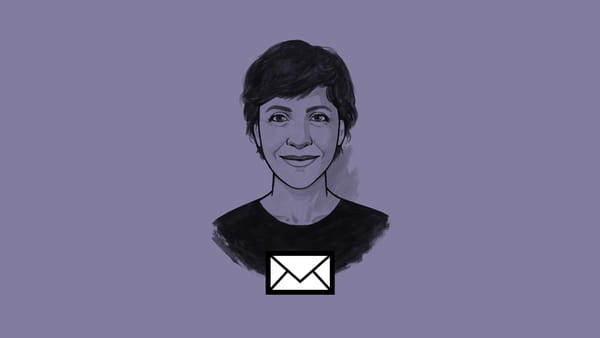Hi,
A few nights ago, my son Lorenzo woke up in the middle of the night. He stood up in bed and started making sounds that referred to some of the experiences he’d had during the day. Miaow, miaow, he said, recalling a cat that had come through our garden. Auto, auto, vroom, vroom, he added, demanding I stand up and take him to the window from where he can see our parked car.
Lorenzo is almost a year and a half old now. He has memories and can even share some of them with us. Wow. It’s a gamechanger. Experiences and people have a longer-lasting effect on him, and I’ve become more aware of that.
When I started as a First 1,000 Days correspondent here at The Correspondent, I was immediately fascinated by the idea of memory. How is it possible that we don’t remember some of the most grounding years of our lives?
I wrote about childhood amnesia, the inability of children to store long-term memories before the age of three and a half. It’s a complex process that involves the ongoing development of brain structures, and I explained it in detail in this article I wrote last October.
Knowing that Lorenzo won’t remember his current experiences in the long run makes me preemptively nostalgic. Every now and then, I try to write letters to him that he can read later and maybe use to recall his early years, and – of course! – we take many pictures and videos of these early days.
But there’s also a different idea that informs my everyday interactions with him: even though he won’t remember details of his first years, his body, mind and psyche will, in one way or another, be informed by them.
Researchers are looking into ways to calculate the physical effects of both positive and negative childhood experiences. This is really important because, as I wrote in this piece, even if a child goes through a traumatic experience, it can be countered by a carer’s love, caring, and safety. And if we have the chance to counter every bad thing that happens to a child, why wouldn’t we?
Our historical memories
I find what happens at a personal level in childhood a good illustration of our historical memories. Even if our generation doesn’t have a direct memory of transatlantic slavery, for example, the scars remain deep in society. And our bodies somehow carry that information on.
Just listen to these words by African-American poet Caroline Randall Williams.
“I have rape-colored skin. My light-brown-blackness is a living testament to the rules, the practices, the causes of the Old South,” she wrote for the New York Times. “It is an extraordinary truth of my life that I am biologically more than half white, and yet I have no white people in my genealogy in living memory. No. Voluntary. Whiteness. I am more than half white, and none of it was consensual. White Southern men – my ancestors – took what they wanted from women they did not love, over whom they had extraordinary power, and then failed to claim their children.”
Randall Williams’s skin and DNA stand as primary sources of a history of slavery, rape and white privilege – a history that cannot be undone, or forgotten, no matter whether it’s in our immediate memory or not.
Take the statues down
In Italy, my native country, we also suffer from historical amnesia. Italy played its role in the colonial occupation of Africa and beyond at the end of the 19th century and beginning of the 20th century. It’s a chapter of our history that I never got taught properly in school, partly because it tends to be hidden among the deeds that Benito Mussolini, the leader of Fascism, carried out when he was in charge.
But there’s a painful colonial history that we’re not telling that still plays out in our everyday lives.
A case in point: when the Black Lives Matter protests erupted in May, the statue of the late Indro Montanelli, one of Italy’s leading journalists, was defaced. When I found out about it, I was surprised. Why Montanelli? How was he connected to Black Lives Matter?
It turns out that Montanelli served in the 1930s during the Italo-Ethiopian war (parts of modern-day Eritrea and Somalia were part of Italy’s colonies). During that period, the late journalist bought, or rather “leased” as he put it, a young Eritrean girl, aged 12 or 14 at the time, from her father. The girl’s name was Fatima or Destà. We will never know for sure because Montanelli referred to her with one name in a 1982 interview and with another name in a column he wrote in 2000.
In the same column, Montanelli went as far as calling the girl a “docile little animal” whose smell he found repulsive, and said her mutilated genitals “provided an almost insurmountable barrier to his ardour” to the point that intercourse became possible only after her mother’s “brutal intervention”.
Montanelli didn’t even show remorse. On the contrary. He insisted that “in tropical countries a girl is already a woman at age 14, and old at age 20.”
How is it possible that I never knew this story – and others like it – until now? It’s possible because of the way that horrific historical actions are talked about and justified as just being “a result of the times”. In the last few weeks on talk shows, white male commentators have been doing just this: using excuses like “that’s what was done at the time” to justify Montanelli’s actions.
But who is supporting and giving a platform to Italy’s Black women who were the subjects, the victims, of those times? Where is their airtime?
Where can Italy’s Black women go to speak of the highly sexualised view of their bodies, for example? Model, blogger and activist Bellamy, who is of Ugandan and Sudanese origins, recently wrote about it on Twitter – but with a far smaller audience than primetime TV, where Montanelli is being justified.
“Black Italian women go from being girls to women in a flash. When you are seen and treated like a prostitute from the age of 10-11, you are denied pre-adolescent innocence and this leads to trauma that we learn to manage on our own and that we don’t talk about enough,” she wrote.
We need to learn about our colonial history in school and think of it from the perspectives of the girls who were abused and raped. We need to start somewhere in order to understand why and how the trauma is perpetuated these days.
But first, we need to take Montanelli’s statue down, in honour of all the new generations of Black Italians.
Which other statues must fall?
In a recent piece, my colleague Patrick Chalmers, who writes about Political literacy, described how he learnt to be vocal about the removal of statues of the colonial past – despite his initial reluctance to show his approval of the defacing of Winston Churchill’s statue in London.
Have you changed your mind about the role of historical statues and symbols in your country? Which statue(s) do you think should fall where you are, and why?
Until next week,
Irene
 Would you like this newsletter straight in your inbox?
Subscribe to my weekly newsletter where I talk about sexuality, reproductive rights and early childhood, discuss the best ideas from members and share updates on my journalism.
Would you like this newsletter straight in your inbox?
Subscribe to my weekly newsletter where I talk about sexuality, reproductive rights and early childhood, discuss the best ideas from members and share updates on my journalism.

